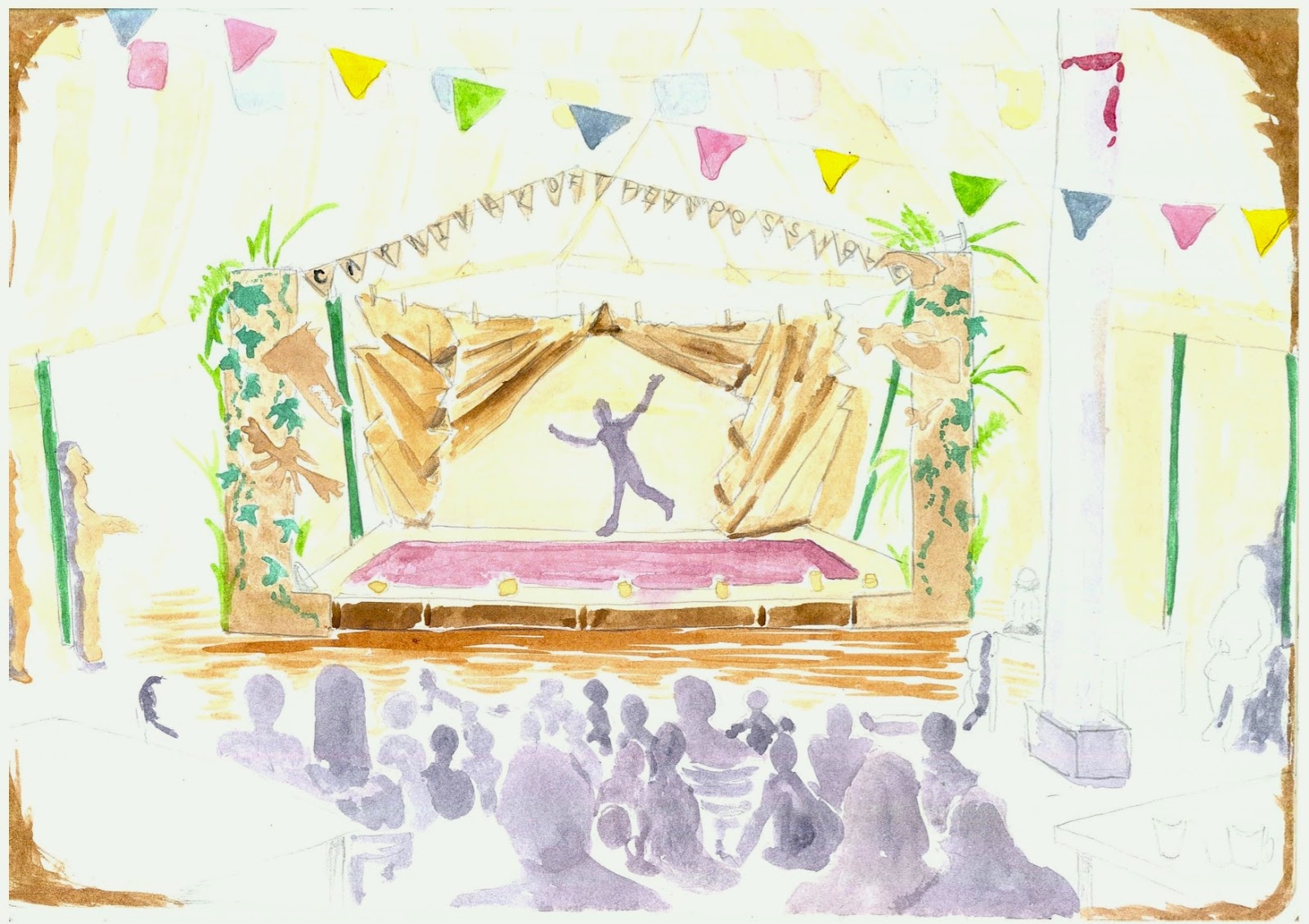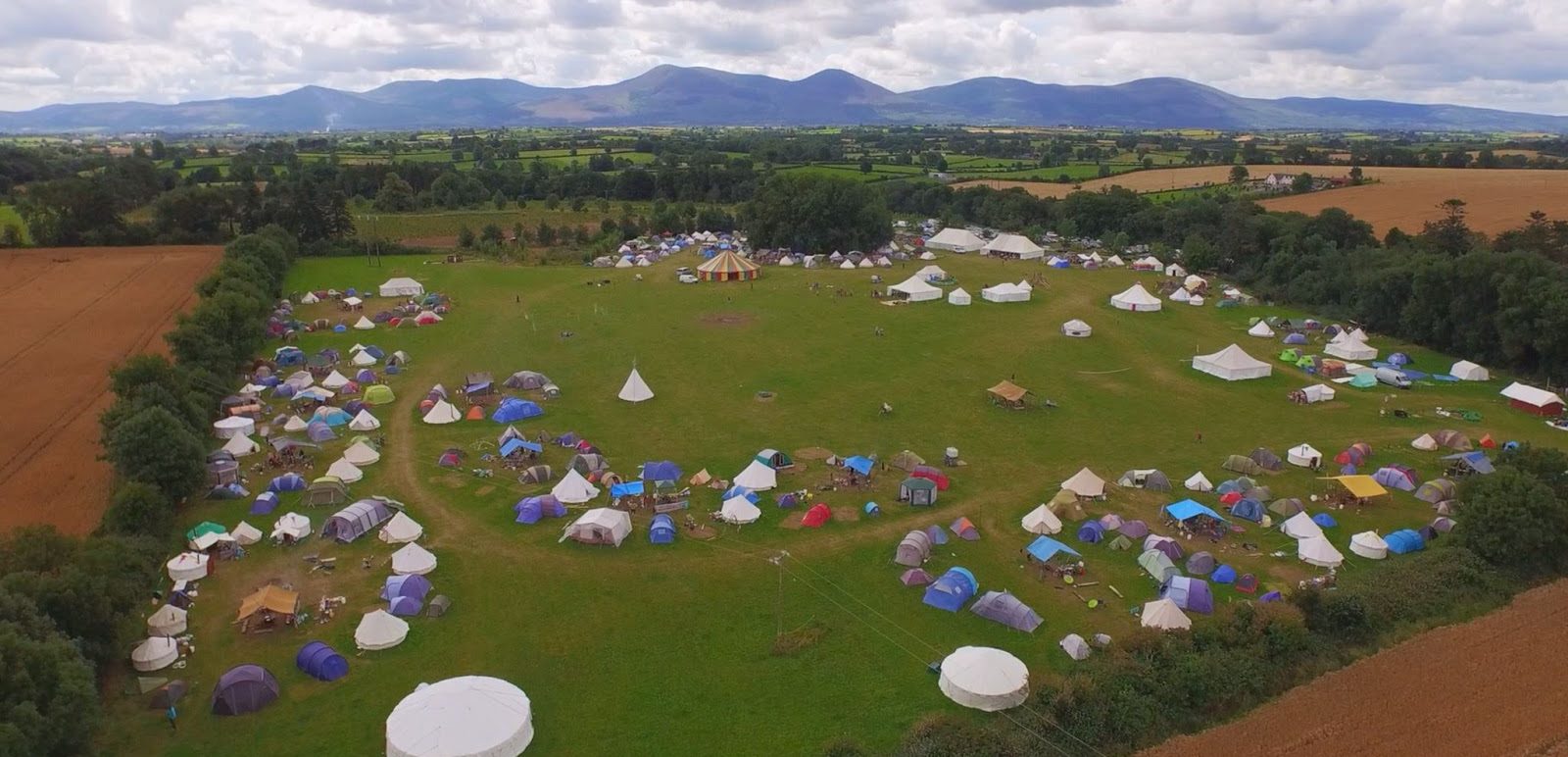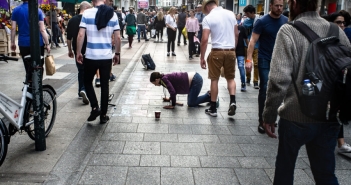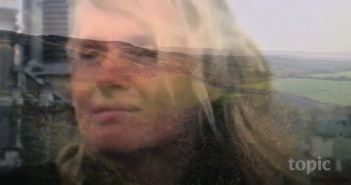Earthsong camps assemble people of all ages, who converge in a natural setting to sing and dance their hearts out. Using the UK-based Unicorn camps as a model, Earthsong was engendered in Ireland by John Bowker and Angie Pinson in 2007. Other influences include Oak Dragon camps, and even Glastonbury.
Earthsong offers an escape from the humdrum: a temporary ‘liminal’ space to explore wildness and sensitivities. As the week progresses the feeling of separation from normality grows. At Earthsong there are no age restrictions leading to a mélange of generations. Families make up the majority of participants, and almost half of those in attendance are under eighteen.
Some come simply for a family holiday, or to spend a sociable week camping; others seek to drop out of ‘reality’ for a period. It is a space where esoteric ideas flourish as like-minded souls celebrate shared outlooks. For some Earthsong counteracts feelings of negativity towards spiritual ideas, born out of compulsion in their religious upbringings.
The field where Earthsong is located is found up a leafy lane-way set away from the road. On arrival participants are greeted by whimsical signs such as ‘Warning, fairies crossing’. Magic is in the air. At the top of the lane, a ‘gatekeeper’, in a fairy costume, greets new arrivals.
Dropping off one’s car on the ‘outside’ before stepping into the arena is the first stage in a rite of passage. Upon arrival participants choose a circle in which to pitch their tent, where it remains for the duration. Each circle contains approximately twenty people. These clusters lie on the edge of the field, while social spaces such as the Big Top, yurts, Big White marquee, café and shop are centrally located.

Throughout the week all live and cook as one over a central fire, and participate in a multitude of group activities. This type of communal living is novel for many – and can be challenging if one is accustomed to the usual separation from one’s neighbours.
It can be intense, both physically and psychologically, but rewarding too. This is an extreme and concentrated example of community, providing insights into how wider communal and ecologically-minded societies could evolve.
II
Earthsong offers a space to explore essential characteristics of our humanity through workshops that are on offer throughout the week. These range from tribal-drumming, basket-weaving, ‘family constellations’, African dance, non-violent communication, laughter-yoga, yurt-making, group-singing, sound-healing to circle dance, depending on the camp. There are two seven-day camps each summer in County Tipperary, ‘Dance Camp’ and ‘Harvest Camp’, as well as two three-day camps in County Clare.
Through altered language, behaviours and activities Earthsong generates separation from the ‘outside world’, or ‘muggle land’, as it is jokingly referred to1. This isolation contributes to the unique atmosphere of the retreat, allowing participants to forget aspects of their lives on the outside.
A serious challenge is the absence of electricity, although, communal showers, heated by a wood-burning stove, are available in a wooden lodge. People are also encouraged to switch off mobile phones, or store them in cars or tents.
There is a strict no alcohol or drugs policy, which provides a rare experience in Ireland, and is a defining feature of the Earthsong experience. ‘Natural highs’ are achieved through events such as drumming and group singing. Safety is the principal rational for this. The ban on intoxicants makes Earthsong family-friendly, and also means everyone is on the same ‘buzz’.
Earthsong is respectful of all spiritual traditions, but is not affiliated to any particular belief system, and organisers consciously avoid dogma. Nonetheless, ritual plays a defining role, from symbolic hand-gestures to welcoming ceremonies, and the Firedance; these generate an aura of mystery and forge community.
Earthsong is a patchwork of cultures and rites, holding each one in equal esteem. The musical practices at Earthsong include west African drumming and chanting, African dance, kirtan, circle dance, folk music, among many others.
III
What is it that attracts people to countercultural, alternative living, such as is experienced at Earthsong, even temporarily? To some extent it is a way of life and set of attitudes that are consciously differentiated from any dominant culture.
This may be born out of dissatisfaction with society as it has developed, where an increasing obsession with technology, a Neoliberal outlook, lack of care for the environment and stressful work-life imbalances leads to alienation, anxiety and a growing culture of fear or distrust. It also reflects a desire to restore spirituality and purpose, and discover alternatives to destructive patterns of unsustainable living2.
An alternative standpoint is to view Earthsong in terms of what people are moving towards rather than what they are running from3. Many who attend Earthsong do not lack for community or a sustainable lifestyle beyond the camp. It often serves to affirm lifestyles rooted in nature and creative thought.
The word liminality derives from the Latin ‘limin’ meaning ‘threshold’, and was first identified by Arnold van Gennep in 1909 in his study Les Rites de Passage. He suggested that customs within social groups are linked to sacred phases. In many instances the passage from one phase to another – whether ageing, illnesses or change in season – involve some sort of ceremony, or rite of passage.
He suggests there are three stages to this ritual process; the first involves a separation from everyday life preliminaire; this is followed by the liminal, or ‘in-between’ phase liminaire, where status is removed and daily routine is replaced by devotion to the sacred. The third phase is reaggregation, or post-liminaire, where the initiate returns to everyday life, newly defined and ‘transformed’ by the ritual journey.
Van Gennep’s description of the liminaire phase inspired Victor Turner in the 1960s to develop the term ‘betwixt and between’ to describe the liminal state of hippies and the Beat Generation (The Ritual Process: Structure and Anti-Structure, 1969).
Van Gennep’s theory had been applied to non-Western societies, but Turner used them for modern society, applying the term ‘liminoid’ for a state of being that was ‘like-liminal’, but not quite. He cited the hippies of the 1960s as examples, especially those choosing to live in a society on the threshold of ‘traditional’, mainstream and structured society.
Turner adopted the term ‘structural outsiderhood’ for a state of mind of ‘normal’ citizens who have yet to reach the ‘utopia’ they wish and fight for. As such, they float in a liminoid space. It is perhaps this ‘liminoid’ element, in combination with the more ‘traditional’, ritual-based liminal element, that best describes the music found at Earthsong.
IV
Communitas is a Latin noun referring either to an unstructured community in which people are equal, or to the spirit of community itself. There are varying levels of communitas operating at Earthcamp, including existential (or spontaneous) communitas in what William Blake knew as the winged moment as it flies4. Ironically, it is the fate of all existential communitas to ‘decline and fall’ into structure.
Loersch and Arbuckle5 argue that music evolved as a mechanism to create and maintain group structure by acting as a form of social communication – a tool to share a group’s mental state with others, without the need for direct interaction. They hypothesised that a musical performance uniquely influences the behaviours and emotions of participants, thus creating a coordinated group.

There is evidence that synchronised movement in response to music amplifies this bonding process. This occurs in dance. Others suggest that ‘musicking’ provides a space where traditional status hierarchies no longer hold (Bergh (2010)6 and Boyce-Tillman (2009)7).
Reilly, in her study of the Magi people of Southeast Brazil, suggests that to experience ‘musical communitas’ is to experience: ‘a sense of intersubjectivity, which neutralises structure and creates the illusion of anti-structure’8. She goes on to suggest that all musical activity entails ritualised behaviour, ‘obscuring the divide’ between the sacred and the profane.
Therefore, ‘enchantment’ is not only found in religious contexts: any environment that encourages an experience of communitas through music conjures an alternative social reality into being.
It is in this world of enchantment that participants construct and experience the ‘harmonious order’ that could merge with an external reality; a mystical vision which is often out of step with dominant ideas in our culture.
In The More Beautiful World Our Hearts Know Is Possible, Charles Eisenstein develops the age-old concept of ‘interbeing’, the idea of everything in the universe being interconnected9. This ‘echoes the worldview’ of ancient tribes and traditions across time and space, challenging us to ‘look beyond the world of concepts and opposites’, and thereby put aside our differences.
Eisenstein speaks of humans experiencing a ‘separation’ from interconnectedness, embodied in money, school, religion and politics, which have the potential to alienate and destruct. He warns against the contemporary ‘glorification of change…of constantly discarding the old’, which may become a form of escapism.
While appropriation of native spirituality has been condemned as cultural murder, Eisenstein suggests this interest comes from a recognition that indigenous peoples have retained for millennia that which ‘we of the West are finally ready to hear, as our own rituals, myths, and institutions break down’.
He uses the term ‘Age of Reunion’ to describe this reintegration. This also offers a defence against the charge of acquisition of anOther’s traditions; looking beyond borders and boundaries and acknowledging our dependence on, and connectedness with, all other members of our species (the important ethical considerations of this concept lie far beyond the reaches of this current research).
V
Throughout the camp Heartsong took place at 8.45 am each morning in the Big Top, after the kirtan session and Dance of Life. Heartsong means to sing ‘from the heart’, to sing one’s emotions out in full, alongside others.
The songs chosen are traditional from a variety of sources as well as contemporary numbers written by Heartsong facilitators. Usually practised in simple four-part harmony in repetitive lines, Heartsong melodies and words tend to evoke powerful emotions.
On one such morning during Dance camp I arrived at 8.40am, just in time to witness the gentle practice of lighting the tea-lights around the altar. It was a slow start, with participants trickling in through one of the four entrances of the tent. We were invited to stand in one of four sections (‘tops’, altos, tenors, bass) in a circle around a central column or ‘altar’.
We were given a short background to the songs we were about to sing, and reassured that we did not have to be great singers. The precise cultural context of the songs was not always of primary importance. Similarly, Tríona Ní Shíocháin in her discussion of Irish traditional song, wrote that in the re-creation of oral transmission, the singer enters a ludic, playful space, where new ideas and interpretations come to the fore, and a collective identity is thereby reinvented10.
In the case of Heartsong where most, if not all, participants are unfamiliar with the language of the lyrics, one is left to interpret feelings through the sound, rather than the meaning of the words. This can represent a space of empathy and imagination.
That morning as we began to learn our parts, through repetition of the slow, simple phrases, more and more people joined the group. Once all the sections were up to speed, we were ready to begin singing in unison.
We began by creating a space of safety, using a Maori signal. This involved placing one’s right hand on the heart and holding the other out in front, with everyone singing a collective ‘ooooo’, while wiggling the fingers of their left hand. Thus we sent a wave of energy from our fingertips to the people around us.
We were reminded that the space of Heartsong might lead to powerful release of emotion. The importance of safety was repeatedly highlighted throughout: there was a recognition that what we were doing could be misconstrued beyond the gates.
The gate-crew could be seen as guarding the entrance ‘over the limen’ into the space of Earthsong, enhancing one’s journey through the camp.
Organisers spoke of our ‘tribe’, and the idea of sending the energy of songs to our ‘people’, be they ‘rivers, animals [or]trees’. We were encouraged to look out for participants whose emotions were triggered by the experience.
At my first camp two years before, I must admit, it was an unsettling sight and sound. We are not accustomed to such raw emotions being on show, we are used to hiding these as we proceed on our generally solitary path through the maze of social life.
Heartsong provides a caring, non-judgmental space in which emotions are welcomed and honoured.
One evening there was a ‘Forest Songs’ session held below a circle of trees, which had a profoundly ethereal quality. It was a unique feeling to sing one’s heart out in the company of trees. On the night approximately sixty participants gathered under the canopy with the singing facilitators in the centre. Faces could only be distinguished by flickering candle-light.
VI
The Firedance, weather-permitting, takes place at the centre of the field as the festival draws to a close. During the day a huge fire of slab-wood and logs are constructed by volunteers.
The drummers attend a practice earlier on the day, so the Firedance commences immediately. We are encouraged to think as a whole community, not just one, and to believe that by taking part in the Firedance we are welcoming ancient traditions, and acknowledging all indigenous communities, who form part of a collective ancestry.
The dangers and force of the fire is not taken lightly, and as I experienced on a windy evening, the flames and smoke are highly unpredictable. The danger is acknowledged and respected, and we are all responsible for one another’s safety. We step into a dangerous environment, but that fire represents life and our wild natures, and reminds us to look out for one another.

While liminal spaces are sites of togetherness and creativity they can also be unsettling, disturbing and dangerous as we confront what is missing from our culture11.
The creation of safe spaces and the altered language and behaviours create a magical environment. This other-worldliness, togetherness and community are crucial factors in encouraging people to return year on year, recreating a temporary space in which to re-imagine themselves, their lives, and the society around them.
I do not wish to overly romanticise Earthsong. It would be impossible to generate a fully ritualistic, liminal space for the duration of the camps. Being a mere week in duration, it is simply a taster of real magic.
As with any gathering of people, festival, or communal living experience, issues arise, rules are broken and behaviours of ‘normal life’ are not easily cast off. Sometimes people sullenly sit in their cars, making phone-calls or updating their Instagram accounts. Children steal from the shop. Families squabble. A child attempts to set the compost loos on fire.
The no-drink-and-drugs rule was broken once or twice (or more) the last time I attended. Complaints are made. Shelters collapse. Eyes sting from cooking over an open fire. Arguments ensue. Earthsong is both very different and quite similar to ‘normal life’.
There are nonetheless pockets of togetherness and shared experience that bind the community, despite all the practical necessities, and mundanities. These are in fact part and parcel of the experience.
Turner writes of the great difficulty in maintaining a permanent state of communitas and that it ‘must sooner or later come to an end. We thus encounter the paradox that the experience of communitas becomes the memory of communitas…’12.
Acknowledgements
I would like to acknowledge all those who interacted with me during fieldwork at Earthsong in July 2016, and am very grateful for the contributions they made to the research.
Reference List
- Dowd, N. (2015). ‘The re-enchantment of the world: the transformative experience of Earthsong camp.’ Undergraduate. University College Cork.
- Ehrenfeld, J. (2008). Sustainability by Design. New Haven and London: Yale University Press, p.64.
- Holyfield, L., Cobb, M., Murray, K., & McKinzie, A. (2013). ‘Musical Ties That Bind: Nostalgia, Affect, and Heritage in Festival Narratives.’ Symbolic Interaction, 36(4), p.457-477.
- Turner, V. (1969). The ritual process. New York: Cornell University Press, p.132.
- Loersch, C. and Arbuckle, N. (2013). ‘Unraveling the mystery of music: Music as an evolved group process.’ Journal of Personality and Social Psychology, 105(5), p.777-798.
- Bergh, A. (2010). I’d like to teach the world to sing: Music and conflict transformation. Ph.D. University of Exeter.
- Boyce-Tillman, J. (2009). ‘The Transformative Qualities of a Liminal Space Created by Musicking.’ Philosophy of Music Education Review, 17(2), p.184-202.
- Reily, S. (2002). Voices of the Magi. Chicago [Ill.]: University of Chicago Press.
- Eisenstein, C. (2013). The More Beautiful World our Hearts Know is Possible. North Atlantic Books.
- Ní Shíocháin, T. (2014). ‘Memory, Liminality and Song Performance: Understanding the History of Thought through Song.’ International Political Anthropology, 7(1), p.73-88.
- Tempest, S., Starkey, K., & Ennew, C. (2007). ‘In the Death Zone: A study of limits in the 1996 Mount Everest disaster.’ Human Relations, 60(7), p.1039-1064.
- Turner, V. (1982). ‘From ritual to theatre.’ New York, NY: Performing Arts Journal Publications.




